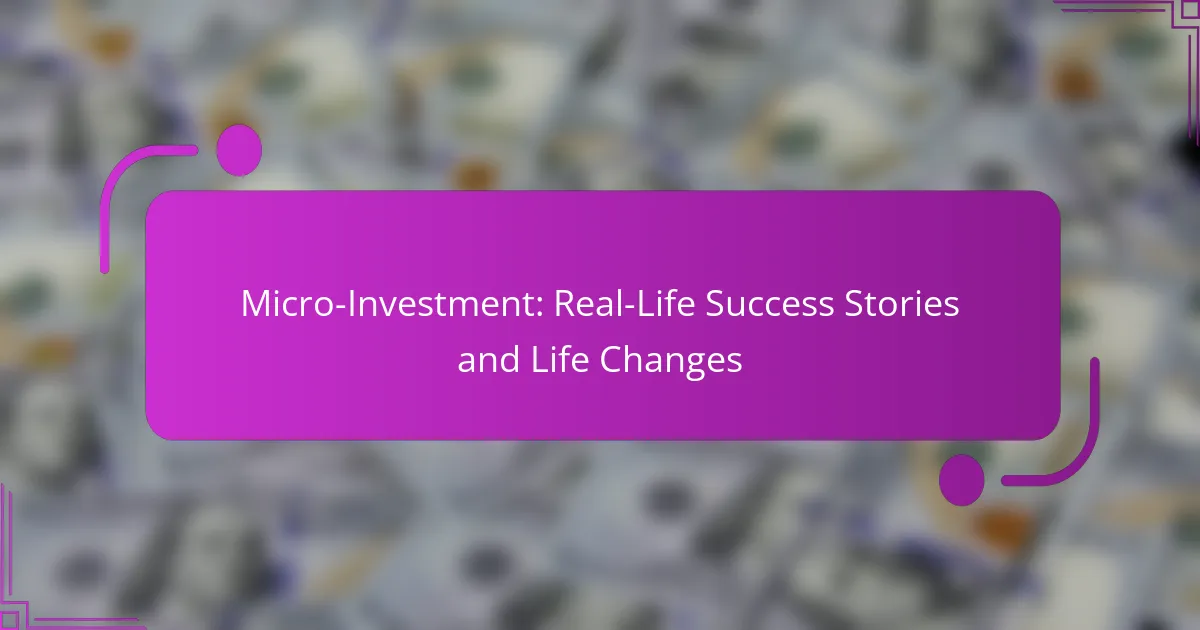Micro-investment offers a practical solution for young professionals aiming to save for homeownership by allowing them to invest small amounts of money on a regular basis. This method enables gradual accumulation of savings without the burden of large financial commitments, making homeownership more attainable. By selecting the right micro-investment platform, individuals can optimize their savings journey while considering factors like fees and investment options.

How can micro-investment help young professionals save for homeownership?
Micro-investment allows young professionals to save for homeownership by enabling them to invest small amounts of money regularly. This approach makes it easier to accumulate savings over time without significant financial strain.
Automated savings through apps
Many micro-investment apps offer automated savings features that help users set aside money effortlessly. By linking a bank account, users can schedule regular transfers to their investment accounts, ensuring consistent contributions towards their homeownership goals.
For example, an app might allow users to set up a weekly transfer of $10, which can accumulate over months or years. This automation reduces the temptation to spend the money elsewhere, making saving more effective.
Round-up investment features
Round-up investment features enable users to invest spare change from everyday purchases. When a user makes a purchase, the app rounds up the total to the nearest dollar and invests the difference.
For instance, if a user buys a coffee for $3.50, the app would round up to $4.00 and invest the extra $0.50. This method allows for incremental savings that can add up significantly over time without requiring large upfront investments.
Low entry barriers for investment
Micro-investment platforms typically have low or no minimum investment requirements, making them accessible for young professionals. Users can start investing with as little as $5 or even less, which encourages participation without the fear of losing large sums.
This low entry barrier democratizes investing, allowing individuals to begin building their wealth early, which is crucial for achieving homeownership. It’s important to choose platforms that align with personal financial goals and offer user-friendly interfaces.

What are the best micro-investment platforms for young professionals?
Young professionals looking to save for homeownership can benefit from several micro-investment platforms. These platforms allow users to invest small amounts of money, making it easier to build savings over time without requiring significant upfront capital.
Acorns
Acorns is a popular micro-investment app that rounds up your purchases to the nearest dollar and invests the spare change. For example, if you buy a coffee for $3.50, Acorns will round it up to $4.00 and invest the extra $0.50. This approach allows users to invest passively without altering their spending habits significantly.
Acorns offers a variety of investment portfolios based on your risk tolerance, and it charges a monthly fee. It’s ideal for beginners who want a hands-off approach to investing while building a savings habit.
Stash
Stash allows users to start investing with as little as $5, making it accessible for young professionals. Users can choose from individual stocks or ETFs, allowing for more control over their investment choices. Stash also provides educational resources to help users learn about investing and personal finance.
One key feature of Stash is its ability to create personalized investment plans based on your financial goals. However, be mindful of the subscription fees, which can add up if you are not actively using the platform.
Robinhood
Robinhood is known for its commission-free trading, making it an attractive option for young investors. Users can buy and sell stocks, ETFs, and cryptocurrencies without incurring fees, which can be particularly beneficial for those just starting out. The platform is user-friendly and offers a straightforward mobile app for easy access.
While Robinhood does not focus specifically on micro-investing, it allows users to start with small amounts. However, it’s essential to be aware of the risks involved in trading and to consider your investment strategy carefully.

How to choose a micro-investment platform?
Choosing a micro-investment platform involves evaluating key factors such as fees, user experience, and available investment options. These elements will significantly impact your savings journey toward homeownership.
Fees and costs comparison
When selecting a micro-investment platform, compare the fees associated with each option. Common fees include account maintenance fees, transaction fees, and management fees, which can range from 0.5% to 2% of your investment annually.
Some platforms offer fee-free options for certain transactions or have tiered pricing based on investment amounts. Always read the fine print to avoid unexpected costs that could eat into your savings.
User experience and interface
A user-friendly interface is crucial for effective micro-investing. Look for platforms that offer intuitive navigation, clear visuals, and easy access to your investment data. A well-designed app can enhance your engagement and make tracking your progress simpler.
Consider reading user reviews or trying out demo versions to gauge the overall experience. A platform that feels cumbersome may deter you from making regular contributions.
Investment options available
Evaluate the range of investment options offered by each micro-investment platform. Many platforms allow you to invest in diversified portfolios, ETFs, or even specific stocks, which can help you align your investments with your financial goals.
Some platforms may focus on socially responsible investments or specific sectors, so choose one that matches your values and investment strategy. Ensure that the platform provides sufficient information on each option to make informed decisions.

What are the benefits of micro-investing for homeownership?
Micro-investing offers young professionals a practical way to save for homeownership by allowing them to invest small amounts of money regularly. This approach not only builds savings but also fosters financial habits that can lead to larger investments over time.
Building financial discipline
Micro-investing encourages young professionals to develop consistent saving habits. By committing to invest even small amounts, individuals learn to prioritize their financial goals and manage their budgets more effectively.
Setting up automatic transfers to investment accounts can help reinforce this discipline. For example, allocating a portion of each paycheck to investments can create a seamless saving routine that becomes part of one’s financial lifestyle.
Access to diversified portfolios
Micro-investing platforms often provide access to diversified portfolios, which can reduce risk compared to investing in single assets. Young professionals can invest in a variety of sectors, including stocks, bonds, and real estate, even with minimal capital.
This diversification allows for a more balanced investment strategy. For instance, investing in a micro-investing app might enable users to hold fractional shares of various companies, spreading their risk across multiple investments.
Potential for compound growth
Micro-investing can harness the power of compound growth, where earnings generate additional earnings over time. Even small contributions can grow significantly due to compounding, especially when investments are held over several years.
For example, investing $50 monthly in a portfolio with an average annual return of 7% could lead to substantial savings over a decade. This potential for growth makes micro-investing an appealing strategy for those aiming to save for a future home purchase.

What are the risks associated with micro-investing?
Micro-investing carries several risks that young professionals should consider before committing their funds. These include market volatility and potentially limited returns compared to traditional investment strategies.
Market volatility
Market volatility refers to the fluctuations in asset prices that can occur over short periods. For micro-investors, this means that the value of their investments can change rapidly, leading to potential losses. Since micro-investing often involves smaller amounts, the impact of these fluctuations can be more pronounced relative to the invested capital.
Young professionals should be prepared for the possibility that their investments may not always grow steadily. It’s advisable to have a long-term perspective and not react impulsively to short-term market changes. Diversifying investments can also help mitigate some of this risk.
Limited returns compared to traditional investing
Micro-investing typically offers lower returns when compared to traditional investment avenues such as stocks or mutual funds. This is partly due to the smaller amounts being invested, which can limit the compounding effect over time. Additionally, many micro-investing platforms charge fees that can further reduce overall returns.
To maximize potential gains, young professionals should consider balancing their micro-investments with other investment options. Setting realistic expectations about returns is crucial; understanding that micro-investing is more about building a habit than achieving significant wealth quickly can help maintain motivation.

How do micro-investments fit into a broader savings strategy?
Micro-investments can play a crucial role in a comprehensive savings strategy by allowing young professionals to gradually build wealth while saving for significant goals like homeownership. By investing small amounts regularly, individuals can take advantage of compound growth and diversify their savings approach.
Complementing emergency funds
Micro-investments should not replace emergency funds but can complement them effectively. An emergency fund typically covers three to six months of living expenses, providing a safety net for unexpected costs. Once a solid emergency fund is established, individuals can allocate a portion of their savings to micro-investments, enhancing their financial resilience.
For instance, if a young professional has an emergency fund of $5,000, they might consider investing an additional $50 to $100 monthly in micro-investments. This approach allows for growth while maintaining liquidity for emergencies.
Integrating with retirement savings
Micro-investments can also be integrated with retirement savings, providing a dual approach to financial planning. While retirement accounts like 401(k)s or IRAs are essential for long-term savings, micro-investments can serve as a flexible option for those who may not have significant disposable income. This strategy allows for incremental contributions that can grow over time.
A practical example is setting up automatic transfers to a micro-investment platform while contributing to a retirement account. For instance, contributing 10% of income to a 401(k) and setting aside an additional $50 a month for micro-investments can create a balanced savings strategy. This way, young professionals can work towards both immediate and long-term financial goals simultaneously.

What are the emerging trends in micro-investing?
Emerging trends in micro-investing highlight a shift towards accessible investment options for young professionals, enabling them to save for significant goals like homeownership. These trends include the rise of user-friendly apps, automated investing features, and a focus on socially responsible investment choices.
Increased Use of Mobile Apps
Mobile applications are revolutionizing micro-investing by allowing users to invest small amounts directly from their smartphones. These apps often feature intuitive interfaces and gamified experiences that make investing engaging and straightforward. Popular platforms like Acorns and Stash enable users to round up purchases and invest spare change effortlessly.
Automated Investment Solutions
Automated investment solutions, such as robo-advisors, are gaining traction among young professionals. These services use algorithms to create and manage investment portfolios based on individual risk tolerance and financial goals. This hands-off approach appeals to busy individuals who may lack the time or expertise to manage investments actively.
Focus on Socially Responsible Investing
Young investors are increasingly interested in socially responsible investing (SRI), which prioritizes ethical and sustainable companies. Micro-investing platforms are responding by offering options to invest in funds that align with environmental, social, and governance (ESG) criteria. This trend allows young professionals to grow their wealth while supporting causes they care about.
Educational Resources and Community Engagement
Many micro-investing platforms are enhancing their offerings with educational resources to empower users. These resources often include articles, webinars, and community forums that provide insights into investment strategies and market trends. Engaging with a community of like-minded investors can also foster a supportive environment for learning and growth.



